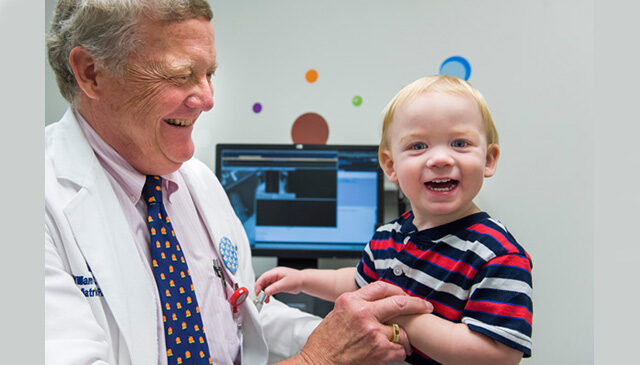
A highly-regarded plastic and orthopedic surgeon, Pederson has also been appointed chief of the Division of Plastic Surgery at Baylor College of Medicine. Read more

A highly-regarded plastic and orthopedic surgeon, Pederson has also been appointed chief of the Division of Plastic Surgery at Baylor College of Medicine. Read more
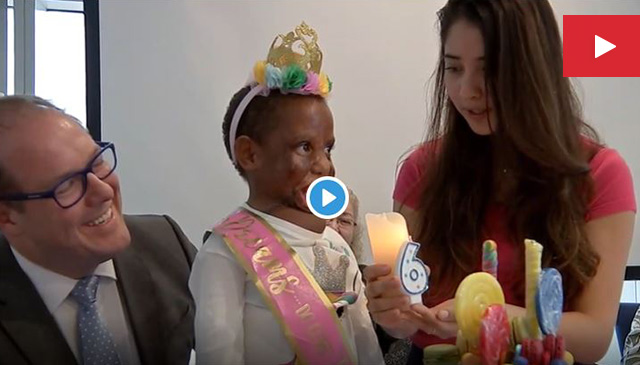
Members of Texas Children’s plastic surgery team have given 6-year-old Elvina Kolevi a chance at a new life after treating injuries she sustained during a burn when she was 2 years old. Watch ABC 13’s story about the little girl’s transformation.
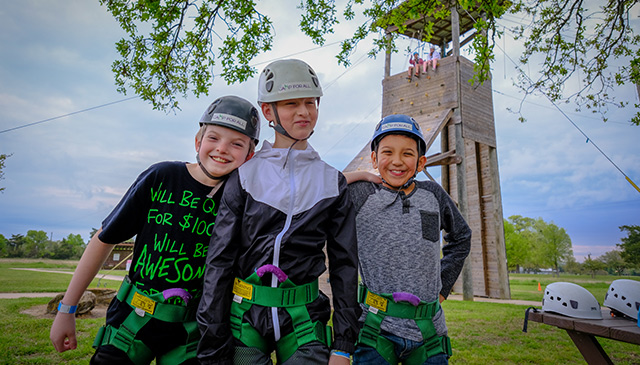
Know any cleft lip and palate patients who could benefit from meeting other people like themselves? If so, tell them about Camp Keep Smiling, a camp for Texas Children’s patients ages 10 to 16 years old with cleft lip and palate.
Hosted by the nonprofit Camp for All, the camp in Burton provides a safe, fun environment for patients between the ages of 10 and 16 to engage in meaningful social interaction and gain self-confidence. Participants can enjoy activities like canoeing, fishing, archery, ropes courses, basketball and arts and crafts.
Texas Children’s Pediatric plastic surgeon Dr. Laura Monson, who helped start the camp, leads the initiative with other team members from the plastic surgery division. Physicians, physician assistants, nurses, OR staff and child life specialists serve as counselors who notice tremendous strides in the campers towards the end of the session.
Admission is free of charge for patients as it is supported directly by donations and the help of generous volunteers.
This year’s camp is scheduled for Friday, March 6, to Sunday, March 8. Applications for patients to attend the camp are available online at this link and are due Friday, February 21. For questions, contact camp coordinator Michelle Roy at mgroy@texaschildrens.org or 832-822-3180.
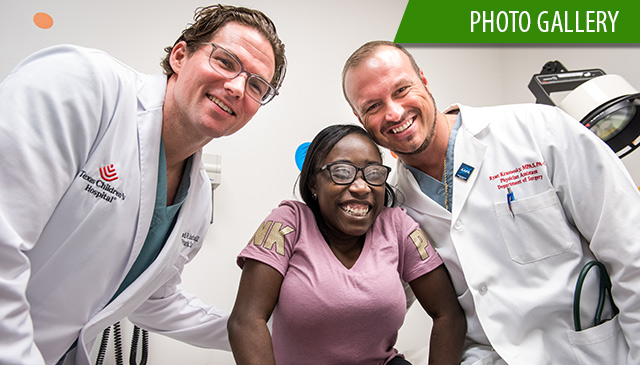
Eighteen-year-old Angeles Vasquez was anxious and scared. For months, a painful wound had lingered on her right ankle. No matter what remedy she and her family tried, it just wouldn’t heal. Unable to find answers or relief elsewhere, they turned to Texas Children’s Hospital and our new pediatric Wound Care Clinic, a new initiative spearheaded by Chief of Plastic Surgery Dr. Edward Buchanan and Director of Surgical Advanced Practice Providers Ryan Krasnosky.
“Dr. Buchanan and Ryan were awesome,” Vasquez said “They gave me the medications I needed and taught me how to properly clean and care for the wound. It’s finally healing and they’re still checking in with me all the time to make sure I’m okay.”
The new Texas Children’s Wound Care Clinic – one of only a few in the country, and the first and only one of its kind in Texas – is a comprehensive center where patients can have a variety of wounds evaluated and treated by an experienced, multidisciplinary team of dedicated medical, surgical, nursing and advanced practice providers.
The team uses evidence-based, standardized treatment protocols – which are under constant scientific scrutiny – to develop individualized treatment plans for each patient. These care plans take into account factors such as wound origin and location, as well as patient and family lifestyle, to determine the best approach to maintenance and to prevent future wounds. Additionally, data from each case is carefully analyzed with the dual goals of improving clinical processes and ensuring care protocols provide the best possible outcomes.
“There is a huge need for this kind of care in Houston and across the United States,” said Buchanan. “We want to lead the way in pediatric wound care on the national level, developing scientifically supported protocols that become the standard of pediatric wound care. With our clinical volume and our dedication to treating these patients, we’re strategically positioned to accomplish this goal.”
Experts in the Wound Care Clinic currently see patients from across the Texas Children’s system at our Texas Medical Center campus, providing high-quality care for a wide range of conditions, including:
“These wounds are often complex and can take quite some time to heal,” said Surgeon-in-Chief Dr. Larry Hollier. “It’s wonderful for a patient to be able to see a team that has all the expertise and products available to heal these wounds in a timely fashion. Additionally, we have the ability to perform minor procedures to speed along the healing and are also able to directly schedule surgeries from the clinic if necessary.”
Still in its beginning phase, the clinic is currently held one day a week. However, in the months since the clinic’s opening, there has been a rapid increase in patient volume, and preliminary plans are already being made for expansion to West Campus and The Woodlands.
“The growth in volume is a testament to the high-quality care our patients are receiving,” Krasnosky said. “Families have been extremely pleased with the care we’re providing and they’ve voiced their appreciation for having a consistent ‘home’ for wound care.”
As the clinic grows, teams will continue to analyze data and lessons learned in order to further standardize clinical processes and care protocols. Long-term goals include the introduction of same-day surgical interventions, for wounds that require more invasive treatment. There are also plans for the integration of a comprehensive research component, with a basic science emphasis on wound healing and clinical research efforts focused on developing evidence-based wound care guidelines, as well as the creation of novel wound treatments and care assessment tools.
In the meantime, clinic care teams are laser-focused on providing the best possible wound care and improving outcomes for every patient who comes to us.
“The Wound Care Clinic is open to any and all wounds that practitioners need assistance with,” Buchanan said. “We hope to get involved early in the care of pediatric wounds within the Texas Children’s system, so as to decrease the time to healing and improve the quality of life of our patients. As our clinic expands, our capacity will expand, and we will be able to provide services to all patient populations. No wound is too trivial or small for an evaluation.”
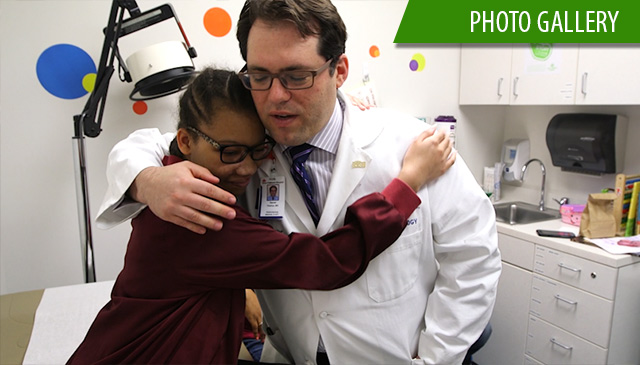
A world-class, multidisciplinary team at Texas Children’s is making huge strides in the care of children with extremely complex tumors.
The Head and Neck Tumor Program, begun in February 2016 as collaboration with partner institutions within the Texas Medical Center, has performed more than 20 major ablation free-flap multidisciplinary cases – a staggering number, considering the rarity and complexity of the tumors, which can be malignant or benign and can affect any combination of the sinuses, skull, jaw, mouth, neck and face. The ability to handle that volume of complex cases, combined with tremendous outcomes in the first two years, puts Texas Children’s Head and Neck Tumor Program among the best such programs in the country.
“Our institutional expertise is in taking care of these kinds of critically ill children, and Texas Children’s does it better than anyone,” said Dr. Daniel Chelius, attending surgeon in the Division of Otolaryngology and co-head of the program. “We’ve built a collaborative, coordinated program on that foundation of expertise in many different areas to provide the best care possible for the sickest children, while also reviewing and analyzing the care from every angle to see what went well and what processes could improve.”
Treatment of children with head and neck tumors around the country has historically been ad hoc, due to the varying functional issues or oncologic needs present from patient to patient and the extreme rarity of the tumors in any given city. Compound these complex physiological issues with the fact that most children these tumors have been treated in adult hospitals and the result has been a largely disjointed approach to care.
Texas Children’s Head and Neck Tumor Program, spearheaded by Chelius and Dr. Edward Buchanan, chief of Plastic Surgery, has developed a coordinated process around a multidisciplinary team approach that builds crucial experience in the treatment of these rare tumors and provides consistent, personalized care for patients – like 15-year-old Kami Wooten.
Last year, Kami began to notice swelling in her gums. Just months later, a benign tumor had covered half her face and threatened her vision. The team at Texas Children’s developed a specialized care plan that included removing the mass and reconstructing a portion of her face including the roof of her mouth and her orbit (eye socket). Additional procedures will be necessary in the future, but Kami and her family are grateful for the care Texas Children’s gave them.
Learn the rest of Kami’s story here.
The collaborative program comprises more than 10 Texas Children’s specialties and subspecialties, including Otolaryngology, Plastic Surgery, Neurosurgery, Oncology, Interventional Radiology and Anesthesiology, as well as a dedicated operating room team – led by Audra Rushing and Kelly Exezidis – that has been instrumental in building robust perioperative protocols. The additions of pediatric head and neck surgeon Dr. Amy Dimachkieh and microvascular reconstructive surgeons Dr. W. Chris Pederson and Dr. Marco Maricevich have increased the program’s abilities and improved the quality of its recommendations.
“It takes a lot of thought and planning to remove these complex tumors completely, while sparing as many nerves and other important structures as possible, and then to reconstruct those structures to provide both a good functional and cosmetic outcome,” Chelius said. “We tell our patients that the process might not be fast because they need the right surgery the first time. That requires recommendations from a team of experts, not just one surgeon. And that means carefully coordinating to make sure everything is as perfect as possible.”
The care required to treat these tumors, particularly if the patient is also undergoing cancer treatment, can also take a massive emotional and psychological toll. The Head and Neck Tumor Program provides additional care support through the department of Clinical Psychology and Child Life Services.
The team also uses technology to enhance the patient experience, from diagnosis to recovery. The program uses 3-D modeling to reconstruct children’s anatomy to help predict the extent of resection and to develop the surgical plan. The team also developed a data-driven protocol for pediatric tracheostomy removal, in close collaboration with Speech and Language Pathology, which uses a pressure monitoring device to signal when the trach is loose enough in the airway to be removed without adverse effects.
As a result of this innovative approach to care, 100 percent of patients treated have left the hospital breathing, eating and swallowing on their own. And the average stay in the hospital: just 14 days.
The program has been steadily building a referral base, drawing patients from across the region and from as far away as Mexico and the Middle East. In the near term, the team will continue to solidify the program, publish data and findings, and work to increase Texas Children’s reputation as the leading referral center for these complex cases. Long-term goals include building a basic science research infrastructure around understanding the underlying causes of these tumors, as well as collaborating with Texas Children’s Cancer Center and other research partners.
“We know that families are coming to us shocked and scared,” Chelius said. “We want them to know that we’re building our experience, we’ve walked families through this before, and we’re going to get them through this with the absolute best care available.”
Learn more about Texas Children’s Head and Neck Tumor Program.
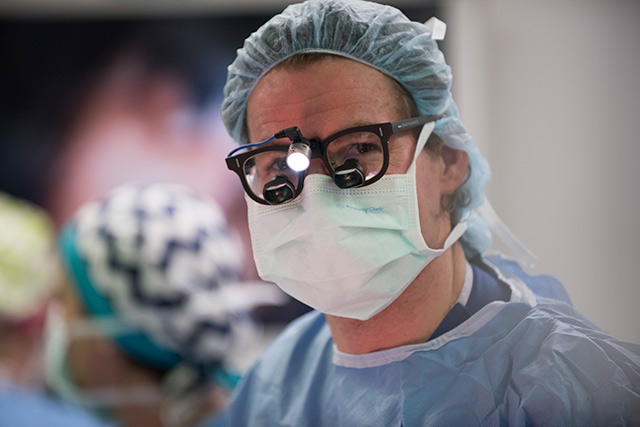 Texas Children’s Hospital is proud to announce Dr. Edward Buchanan as chief of plastic surgery effective May 9.
Texas Children’s Hospital is proud to announce Dr. Edward Buchanan as chief of plastic surgery effective May 9.
Buchanan, who specializes in pediatric plastic surgery and craniofacial surgery, joined Texas Children’s and Baylor College of Medicine in 2011. Throughout his tenure, he has served in numerous leadership roles and has been integral in many complex cases, including the successful separation of two sets of conjoined twins.
“I am honored to be named to this esteemed leadership position,” said Buchanan. “Our team is committed to helping our patients function at the highest level so they feel and look their best. I am excited to continue to expand our world-class multidisciplinary programs as well as our surgical research and innovation.”
Buchanan earned his medical degree from The Medical University of South Carolina and completed his residency in plastic and reconstructive surgery at Stanford University School of Medicine. He also completed a fellowship in craniofacial/pediatric plastic surgery at Seattle Children’s Hospital/Harborview Medical Center. His areas of interest include pediatric craniofacial surgery, cleft lip and palate surgery, facial trauma, maxillary and mandibular distraction, and pediatric oncologic reconstruction.
To learn more visit texaschildrens.org/plasticsurgery.
Forty-five campers attended Camp Keep Smiling March 23-25, participating in everything from arts and crafts to ropes courses and more.
Camp Keep Smiling is a camp for children with cleft lip and palate. Hosted by the nonprofit Camp for All, the camp provides a safe, fun environment for patients between the ages of 10 and 16 to engage in meaningful social interaction and gain self-confidence. Participants can enjoy activities like canoeing, fishing, archery, ropes courses, basketball and arts and crafts.
Admission is free of charge for patients as it is supported directly by donations.
Texas Children’s Pediatric plastic surgeon Dr. Laura Monson, who helped start the camp, leads the camp with other team members from the plastic surgery division. Physicians, nurses, OR staff and child life specialists serve as counselors who notice tremendous strides in the campers towards the end of the session.